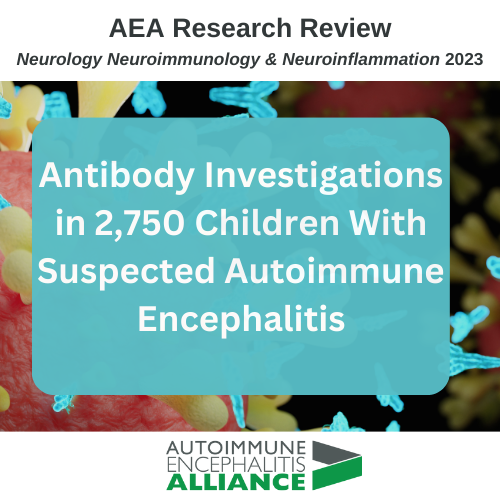Antibody associations in 2750 children with suspected autoimmune encephalitis
February 12, 2024

Making the diagnosis of autoimmune encephalitis (AE) can be very straightforward when the patient develops features that are highly characteristic of a particular AE. For example, a 30-year old woman with new onset psychiatric symptoms such as hallucinations or strange behaviors and who also has repetitive movements around their mouth in their face (known as orofacial dyskinesias) likely has anti-NMDAR encephalitis.
The situation in children is very different. The presentation of AE in young patients can be vague. A child may become irritable or less talkative. Even having a seizure may not be very helpful in pointing at the diagnosis because so many disorders can cause seizures in children. Eventually, over days or possibly a few weeks, if the child has AE, they develop more symptoms that are then very helpful. But no one wants to wait days or weeks. So how do we make a quick and correct diagnosis?
As discussed in a previous AEA Research Review (Clinical Approach To The Diagnosis Of Autoimmune Encephalitis In The Pediatric Patient) physicians develop criteria that patients must meet before they can be given the diagnosis of possible AE. For the diagnosis of definite AE, the child needs to have a positive antibody test. Thus, antibody testing can be highly valuable as part of the initial evaluation. But what antibodies do you test for? Why not test for all antibodies found in AE?
There are several reasons to not do this, including among others, the more antibodies you test for, the increased chance you will receive a positive result that is not really positive (called a false positive result). But since the physician does not know it is a false positive result the patient gets treated for AE when they really have a different diagnosis that may need different treatment. Another important reason is that the more antibodies you test for the higher the cost and this is not trivial as we all know about the high cost of health care.
A recently published study addressed this issue. In this study, the authors evaluated 2750 pediatric patients (younger than 18 years) who were suspected of having AE. The authors comprehensively examined the serum and CSF of the patients for 21 antibodies known to be associated with AE in adults and children. Out of all these pediatric patients about 20% (one fifth) had an antibody in either their serum, CSF or both. Most of the antibody positive patients (76% or three quarters) had antibodies to NMDAR. Antibodies to myelin oligodendrocyte glycoprotein (MOG) were the second most common antibody but were only found in 5% of the antibody positive patients while GAD65 and GABAaR antibodies were each found in 2% of the patients. Other types of antibodies were found in a single or just a few patients, making them very rare.
What this study is showing us is that when it comes to antibody associated AE in children one should think anti-NMDA receptor encephalitis and then possibly MOG associated disorders. The results demonstrate that initial testing for just these 2 disorders will confirm or rule out the diagnosis in most pediatric cases. This leads the authors to conclude that upfront testing of large panels of antibodies is not needed in these patients and that avoiding this unnecessary testing will reduce diagnostic errors. While the authors did not focus on the cost savings, this clearly will be another benefit.
This study will help practitioners to more rapidly and accurately diagnose AE in pediatric patients. Along with the rigorous application of clinical criteria, this study is a positive step forward in the care of these young patients.
Thank you Myrna Rosenfeld, MD, a member of the AEA Medical Advisory Board for providing the February 2024 AEA Research Review.